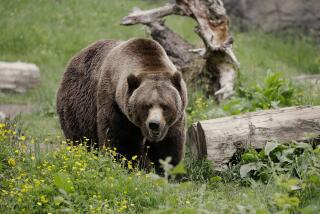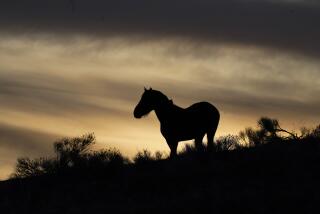Safeguards for grizzlies are revived
- Share via
SEATTLE — A federal judge Monday restored protections for grizzly bears near Yellowstone National Park, overturning a George W. Bush administration finding that the animals had made an “amazing” and sustainable recovery.
In a strongly worded order, U.S. District Judge Donald W. Molloy said that the U.S. Fish and Wildlife Service’s conclusion that the bears would find adequate food and protected habitat in Wyoming, Montana and Idaho was not supported by the government’s own science, and that protections put into place for the grizzlies were not enforceable.
The ruling largely supported conservationists’ assertion that the predators faced devastating losses to one of their most important food sources as a result of climate change. It ordered the government to put the bears back under the protection of the Endangered Species Act until long-term strategies to assure their survival were in place.
“Much of the science [cited by the government] directly contradicts the service’s conclusions,” the judge wrote in his 46-page decision. “Where the agency’s conclusions contradict the science, the conclusions are not reasonable, and the court need not defer to the agency’s decision.”
Matt Kales, a spokesman for the Fish and Wildlife Service, said officials could not comment on the ruling until they had a chance to review it in detail. “Obviously, we’re going to take a long, hard look at the judge’s ruling to try to discern both what it means for daily management of the bear and also look at it from a policy and legal standpoint and determine what our options are,” he said.
There are about 580 bears in the three-state area near Yellowstone and Grand Teton national parks.
Molloy’s decision reverses the federal government’s 2007 conclusion that grizzly bears, which had been wiped out of more than 98% of their historic range across the continental U.S. by the 1950s, were “thriving” in the Yellowstone area after 32 years of protection.
“There is no way to overstate what an amazing accomplishment this is,” former Deputy Interior Secretary Lynn Scarlett said at the time.
The Greater Yellowstone Coalition led a lawsuit challenging the delisting. The conservation group argued, among other things, that the government had failed to consider the loss of white bark pine nuts because of climate change. The nuts are a vital food source for the grizzlies, and the trees that produce them have died off as warmer winter temperatures have allowed the beetles that feast on them to flourish.
“With global warming, the beetles are able to survive the winter. And also because the warm season is longer, instead of getting one reproductive cycle, you get two or even three,” said Doug Honnold, who argued the case for the Earthjustice legal defense fund.
Bears wandering out of the wilderness in search of food have been killed by hunters and wildlife control officials trying to protect neighborhoods.
“A record 79 bears died last year, or 13% of the population,” Louisa Willcox, senior wildlife advocate for the Natural Resources Defense Council, said in a statement. “The judge recognized what we have been saying all along: Protecting grizzlies requires enforceable, science-based standards to protect habitat.”
Molloy did find that the government had adequately defined the expanse of the bears’ present-day ranges, and also upheld the Fish and Wildlife Service’s finding that the bears -- though isolated from grizzly populations elsewhere in Montana and Canada -- will be able to maintain their genetic diversity.
--
More to Read
Sign up for Essential California
The most important California stories and recommendations in your inbox every morning.
You may occasionally receive promotional content from the Los Angeles Times.













